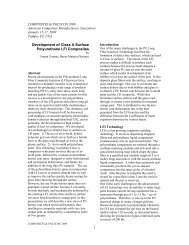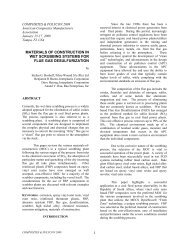heydar aliyev cultural center - Kreysler & Associates
heydar aliyev cultural center - Kreysler & Associates
heydar aliyev cultural center - Kreysler & Associates
You also want an ePaper? Increase the reach of your titles
YUMPU automatically turns print PDFs into web optimized ePapers that Google loves.
<br />
construction equipment. Taking all of the above factors into account, it was decided that <br />
the construction equipment should be left out of the analysis. <br />
The manufacturing location of both materials has not yet been finalized. The proposed <br />
location for fabrication of the FRP panels is Istanbul, Turkey. Stuttgart, Germany has <br />
been proposed for the GFRC, but this is still uncertain. There is also the possibility that <br />
either material could be manufactured more locally in Azerbaijan, particularly in Baku. <br />
Based on the likelihood of these scenarios, Istanbul and Stuttgart have been chosen for <br />
the manufacturing locations for the base case analysis. In addition analysis has been <br />
conducted considering only minimal transportation, to determine the level of effect of <br />
choosing local manufacturing. Details of each of these analyses can be found in results <br />
below. <br />
Inventory Analysis <br />
FRP Panels <br />
According to the manufacturer, the composition (per square foot) of the FRP panel is: <br />
0.25 lb. gelcoat (NPG gelcoat), 1.0 lb polyester resin (Hetron 814A), 0.67 lb. alumina <br />
trihydrate filler, and 0.72 lb glass (alternating layers of 24 oz woven roving and 1.5 oz <br />
CSM). Additional materials required in the manufacturing process are vacuum bag <br />
plastic (product # RBG 2601‐MCF), which may be reused for approximately 50 parts, and <br />
rubber tape (product # GS 43 MR 1/8"x1/2"x25'), which is not reused. The <br />
manufacturing process also requires 2 hours of vacuum pumping with an 816.5 W <br />
pump. A mold is also required in the process, but since the same type of mold is use for <br />
both the FRP and GFRC, it was not included in the model. <br />
GFRC Panels <br />
Data on the specific design or manufacturing process of the GFRC panels was not <br />
available, and therefore industry standards were used to generate an approximate <br />
design. Initially, the model included a GFRC panel thickness of 3” (a verbal <br />
recommendation from an industry professional). However, after performing the <br />
sensitivity analysis (described in Section 4), it was clear a refined thickness should be <br />
determined. This updated thickness was calculated such that the GFRC and FRP panels <br />
would have equal flexural strength based on industry‐tabulated values. The average <br />
value of maximum stress for FRP is 20,000 psi, and for GFRC is from 1,300 to 2,000 psi. <br />
Flexural strength is defined as: σ = 3FL / 2bd^2, where F is the force applied in a three‐<br />
point loading test, L is the length of the specimen, b is the width, and d is the thickness. <br />
Using an average of 1650 psi for the flexural strength of GFRC, a thickness of <br />
approximately 1.5" was calculated to match the flexural strength of 0.433" (11mm) thick <br />
FRP. The estimate for the glass content of the GFRC, suggested by Bill <strong>Kreysler</strong>, was 8% <br />
by volume, and is within the normal range of industry standards. <br />
6




